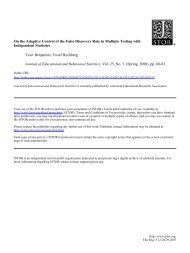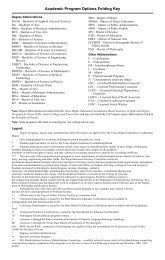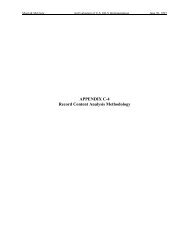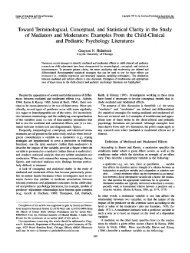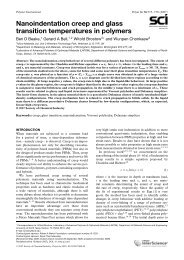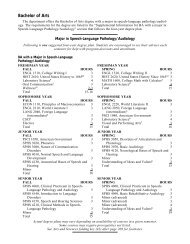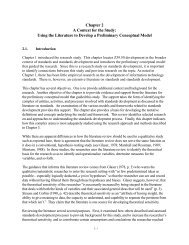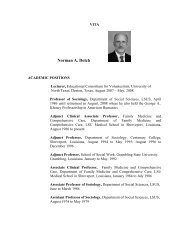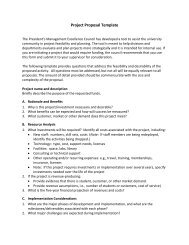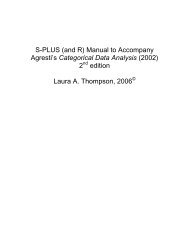Connection of surface tension with multiple tribological properties in ...
Connection of surface tension with multiple tribological properties in ...
Connection of surface tension with multiple tribological properties in ...
Create successful ePaper yourself
Turn your PDF publications into a flip-book with our unique Google optimized e-Paper software.
Polymer International Polym Int 52:1498–1505 (2003)<br />
DOI: 10.1002/pi.1283<br />
<strong>Connection</strong> <strong>of</strong> <strong>surface</strong> <strong>tension</strong> <strong>with</strong> <strong>multiple</strong><br />
<strong>tribological</strong> <strong>properties</strong> <strong>in</strong><br />
epoxy + fluoropolymer systems<br />
Witold Brostow, 1∗ Patrick E Cassidy, 2 Javier Macossay, 2 Dorota Pietkiewicz 1<br />
and Sreenu Venumbaka 2<br />
1 Laboratory <strong>of</strong> Advanced Polymers and Optimized Materials (LAPOM), Department <strong>of</strong> Materials Science, University <strong>of</strong> North Texas,<br />
Denton, TX 76203-5310, USA<br />
2 The Shell Center for Polymer Science & Technology, Department <strong>of</strong> Chemistry, Southwest Texas State University, San Marcos,<br />
TX 78666, USA<br />
Abstract: Contact angles <strong>of</strong> free liquids on solid samples were measured and the van Oss–Good method was<br />
applied for evaluat<strong>in</strong>g <strong>surface</strong> <strong>tension</strong>s <strong>of</strong> the solids. A parachor method was used for comparison: <strong>in</strong> this<br />
case the respective values were calculated for the polymer solids from molecular and group contributions.<br />
Surface <strong>tension</strong>s were computed from the parachors and the two methods compared. Effects <strong>of</strong> vary<strong>in</strong>g<br />
the fluoropolymer added to the epoxy before cur<strong>in</strong>g are discussed. For a given fluoropolymer, effects<br />
<strong>of</strong> chang<strong>in</strong>g its concentration on <strong>surface</strong> <strong>tension</strong> have also been evaluated and compared to the changes<br />
<strong>in</strong> scratch resistance (scratch penetration depth, recovery depth) and <strong>in</strong> static and dynamic friction.<br />
Morphological and phase structure changes are reflected <strong>in</strong> all these <strong>properties</strong>, show<strong>in</strong>g a strong<br />
connection between the <strong>surface</strong> <strong>tension</strong> and <strong>tribological</strong> <strong>properties</strong>.<br />
© 2003 Society <strong>of</strong> Chemical Industry<br />
Keywords: polymer <strong>surface</strong> <strong>tension</strong>; wett<strong>in</strong>g angle; polymer tribology; epoxy <strong>surface</strong> modification; fluoropolymers<br />
INTRODUCTION<br />
Epoxy res<strong>in</strong>s are widely used and well known for their<br />
mechanical <strong>properties</strong>. 1–3 Their structures are <strong>in</strong>vestigated<br />
by several techniques <strong>in</strong>clud<strong>in</strong>g positron annihilation<br />
spectroscopy. 4 Each year <strong>in</strong>dustrial demand<br />
for advanced polymeric materials that can successfully<br />
substitute for metal parts is <strong>in</strong>creas<strong>in</strong>g dramatically.<br />
Given the importance <strong>of</strong> epoxy-based materials <strong>in</strong> the<br />
substitution process, they constitute one <strong>of</strong> the areas<br />
<strong>of</strong> activity for our group. 5–12 In particular, we use peroxides<br />
for crossl<strong>in</strong>k<strong>in</strong>g epoxies, 5–7,10,12 as do Seppälä<br />
and coworkers for crossl<strong>in</strong>k<strong>in</strong>g ε-caprolactone. 13<br />
Although very useful, epoxies have several disadvantages,<br />
<strong>in</strong>clud<strong>in</strong>g high friction and low resistance<br />
to scratch and abrasion. We have assumed that<br />
modification <strong>of</strong> the epoxy res<strong>in</strong>s <strong>with</strong> a material<br />
exhibit<strong>in</strong>g dist<strong>in</strong>ctly different <strong>properties</strong> might be a<br />
remedy for these problems. It appears that this modifier<br />
could be fully fluor<strong>in</strong>ated poly(aryl ether ketone)<br />
(12F-PEK). 14,15 Our goal is to obta<strong>in</strong> epoxy-based<br />
materials <strong>with</strong> high scratch resistance <strong>in</strong> particular,<br />
as well as endowed <strong>with</strong> specific chemical, electrical,<br />
magnetic and optical <strong>properties</strong>. Among many<br />
physical <strong>properties</strong>, <strong>surface</strong> <strong>tension</strong> is important when<br />
wett<strong>in</strong>g and adhesion <strong>of</strong> liquid on solid <strong>surface</strong> is<br />
16 – 20<br />
<strong>in</strong>volved.<br />
This work has been preceded by a complementary<br />
study deal<strong>in</strong>g <strong>with</strong> other <strong>surface</strong> <strong>properties</strong> <strong>of</strong> polymer<br />
blends—namely <strong>tribological</strong> <strong>properties</strong>. We have<br />
reported 14 that both static and dynamic friction<br />
<strong>of</strong> samples cured at 24 ◦ C decreases significantly<br />
by add<strong>in</strong>g as little as 5% 12F-PEK, and rema<strong>in</strong>s<br />
practically constant above 10% 12F-PEK. Scann<strong>in</strong>g<br />
electron microscopy (SEM) micrographs supported<br />
our explanation that the significant improvement at<br />
such a low concentration <strong>of</strong> fluoropolymer is due to<br />
the existence <strong>of</strong> two phases: fluoropolymer movement<br />
towards the <strong>surface</strong> and phase <strong>in</strong>version; 12F-PEK<br />
becomes the matrix <strong>in</strong> spite <strong>of</strong> its low concentration.<br />
In the second paper 15 we demonstrated that significant<br />
scratch recovery as well as a lower orig<strong>in</strong>al penetration<br />
depth are obta<strong>in</strong>ed for blends cured at 24 ◦ C <strong>with</strong><br />
aga<strong>in</strong> only 5 wt% concentration <strong>of</strong> 12F-PEK.<br />
These promis<strong>in</strong>g results encouraged us to <strong>in</strong>vestigate<br />
other <strong>surface</strong> <strong>properties</strong> <strong>of</strong> the above system. We now<br />
look for connections between friction and scratch<br />
resistance <strong>in</strong>vestigated previously and <strong>surface</strong> <strong>tension</strong>,<br />
which is the subject <strong>of</strong> the present paper. As already<br />
∗ Correspondence to: Witold Brostow, Laboratory <strong>of</strong> Advanced Polymers and Optimized Materials (LAPOM), Department <strong>of</strong> Materials<br />
Science, University <strong>of</strong> North Texas, Denton, TX 76203-5310, USA; http://www.unt.edu/LAPOM<br />
E-mails: brostow@unt.edu; pc03@swt.edu<br />
Contract/grant sponsor: State <strong>of</strong> Texas Advanced Research Program, Aust<strong>in</strong>; contract/grant number: 003593-0075-1999<br />
(Received 28 December 2002; revised version received 10 March 2003; accepted 28 March 2003)<br />
Published onl<strong>in</strong>e 4 August 2003<br />
© 2003 Society <strong>of</strong> Chemical Industry. Polym Int 0959–8103/2003/$30.00 1498
Surface <strong>tension</strong> and <strong>tribological</strong> <strong>properties</strong> <strong>in</strong> epoxy + fluoropolymer systems<br />
noted, the m<strong>in</strong>or component, due to its low <strong>surface</strong><br />
energy, travels to the <strong>surface</strong> and becomes the matrix;<br />
we expected that the <strong>surface</strong> <strong>tension</strong> would be highly<br />
dependent on the 12F-PEK concentration as well.<br />
EXPERIMENTAL<br />
Materials<br />
The fluoropolymer (12F-PEK) was synthesized <strong>in</strong><br />
the Department <strong>of</strong> Chemistry at Southwest Texas<br />
State University. 21,22 The chemical formula is given<br />
<strong>in</strong> Fig 1. Its <strong>properties</strong> have been described before. 14<br />
The epoxy used was the diglycidyl ether <strong>of</strong> bisphenol<br />
A res<strong>in</strong> (Shell Chemicals, EPON 828), which was<br />
cured <strong>with</strong> an aliphatic am<strong>in</strong>e (triethylenetetram<strong>in</strong>e<br />
(TETA), Shell Chemicals—EPI-CURE 3234. Its<br />
most probable formula is shown <strong>in</strong> Fig 2.<br />
Half <strong>of</strong> the samples was cured at 70 ◦ C for 3 h while<br />
the other half was cured at 24 ◦ C <strong>in</strong> order to simulate<br />
room temperature cur<strong>in</strong>g applications. The cur<strong>in</strong>g was<br />
performed <strong>in</strong> Teflon moulds; no mould release was<br />
used. Top and bottom <strong>surface</strong>s <strong>of</strong> the samples were<br />
exam<strong>in</strong>ed. The details <strong>of</strong> blend preparation were given<br />
<strong>in</strong> Reference 14.<br />
while the radius r = R s<strong>in</strong> θ. From these relationships<br />
we obta<strong>in</strong><br />
θ = 2arc tan h (1)<br />
r<br />
Precise measurements <strong>of</strong> h and r values are performed<br />
by means <strong>of</strong> an appropriate optical system. Geometric<br />
parameters <strong>of</strong> the drop are easy to determ<strong>in</strong>e on a<br />
magnified image. Details <strong>of</strong> this approach have been<br />
23 – 26<br />
discussed by several authors.<br />
In general, there is a variety <strong>of</strong> experimental<br />
techniques for determ<strong>in</strong>ation <strong>of</strong> <strong>surface</strong> <strong>tension</strong>:<br />
measurements <strong>of</strong> the force needed to lift a r<strong>in</strong>g from<br />
the liquid <strong>surface</strong>, capillary rise, Laplace’s hang<strong>in</strong>g<br />
droplet, and more. In our case, experiments were<br />
performed as follows. The conta<strong>in</strong>er <strong>with</strong> a liquid was<br />
prepared and the syr<strong>in</strong>ge needle was immersed <strong>in</strong>to<br />
the liquid. The syr<strong>in</strong>ge was then filled <strong>with</strong> the liquid<br />
and the excess liquid was wiped <strong>of</strong>f. The air bubbles<br />
were elim<strong>in</strong>ated by po<strong>in</strong>t<strong>in</strong>g the needle upwards and<br />
rotat<strong>in</strong>g the sleeve until the liquid started squirt<strong>in</strong>g<br />
out. Then the dispenser assembly was lowered along<br />
the guide and the lock<strong>in</strong>g knob tightened. This was<br />
Contact angle measurements<br />
Contact angle measurements <strong>of</strong> liquid droplets on<br />
polymer were used to characterize <strong>surface</strong> wettability.<br />
The contact angle is def<strong>in</strong>ed as the angle between<br />
the polymer support <strong>surface</strong> and the tangent l<strong>in</strong>e at<br />
the po<strong>in</strong>t <strong>of</strong> contact <strong>of</strong> the liquid droplet <strong>with</strong> the<br />
polymer (Fig 3). The <strong>surface</strong> <strong>of</strong> a drop <strong>of</strong> a liquid<br />
placed on a solid can be represented by a spherical<br />
cap; <strong>in</strong> such a case the contact angle θ is calculated<br />
from the height <strong>of</strong> the cap h and the radius <strong>of</strong> the<br />
solid–liquid contact area r. The height <strong>of</strong> the spherical<br />
cap is represented by the equation h = R(1 − cos θ)<br />
R<br />
q<br />
a<br />
h<br />
r<br />
O<br />
O<br />
CF 3<br />
C<br />
C<br />
C<br />
CF 3<br />
O O<br />
C<br />
CF 3<br />
CF 3<br />
Figure 1. Chemical formula <strong>of</strong> 12F-PEK.<br />
Figure 3. Contact angle determ<strong>in</strong>ation.<br />
EPON TM 828<br />
O<br />
CH 3<br />
O<br />
CH 2<br />
CH<br />
CH 2<br />
( R ) n O<br />
C<br />
O CH 2 CH CH 2<br />
CH 3<br />
CH 3<br />
OH<br />
R =<br />
O<br />
C<br />
O<br />
CH 2<br />
CH<br />
CH 2<br />
CH 3<br />
TETA<br />
H 2 N<br />
( CH2 CH 2 NH ) 2<br />
CH 2 CH 2<br />
NH 2<br />
Figure 2. Chemical formula <strong>of</strong> diglycidyl ether <strong>of</strong> bisphenol A res<strong>in</strong> cured <strong>with</strong> an aliphatic am<strong>in</strong>e, triethylenetetram<strong>in</strong>e (TETA).<br />
Polym Int 52:1498–1505 (2003) 1499
WBrostowet al<br />
Table 1. Results <strong>of</strong> contact angle measurements<br />
Bottom <strong>of</strong> the samples<br />
Top <strong>of</strong> the samples<br />
Weight %<br />
12F-PEK<br />
Cur<strong>in</strong>g<br />
temperature ( ◦ C)<br />
θ<br />
(H 2 O)<br />
θ<br />
(Diiodomethane)<br />
θ<br />
(Glycerol)<br />
θ<br />
(H 2 O)<br />
θ<br />
(Diiodomethane)<br />
θ<br />
(Glycerol)<br />
0 37 47 36 28 45 35<br />
5 54 46 57 51 47 58<br />
10 24 62 45 52 59 47 54<br />
15 70 44 62 69 48 65<br />
20 72 55 55 72 58 53<br />
0 63 47 62 61 47 63<br />
5 60 60 66 62 60 68<br />
10 70 74 61 65 67 62 66<br />
15 71 68 67 74 64 67<br />
20 83 54 57 84 54 62<br />
all done <strong>with</strong>out disturb<strong>in</strong>g the specimen table or the<br />
component to be tested. Then the illum<strong>in</strong>ator was<br />
activated by switch<strong>in</strong>g on the power. The sample was<br />
placed <strong>in</strong> the specimen holder and secured <strong>with</strong> spr<strong>in</strong>g<br />
clamps. The test<strong>in</strong>g <strong>surface</strong> was located precisely<br />
under the tip <strong>of</strong> the syr<strong>in</strong>ge needle and the knob <strong>of</strong> the<br />
micrometer syr<strong>in</strong>ge rotated clockwise to release the<br />
desirable amount (10 divisions on the screen) <strong>of</strong> the<br />
test<strong>in</strong>g liquid. Then the specimen holder was brought<br />
up until the droplet touched the <strong>surface</strong> and the<br />
specimen holder was lowered to complete the transfer<br />
<strong>of</strong> the droplet. The contact angle was measured by<br />
rotat<strong>in</strong>g the clear protractor <strong>with</strong> a hairl<strong>in</strong>e on the<br />
measur<strong>in</strong>g screen until the hairl<strong>in</strong>e crossed the apex.<br />
The contact angle measurements <strong>of</strong> sessile drops <strong>of</strong><br />
pure liquid on smooth polymer <strong>surface</strong> were taken.<br />
This was repeated ten times for each polymer + liquid<br />
pair and then the mean value calculated.<br />
The contact angles were measured at 25 ◦ C<br />
on a contact angle meter Model CAM-MICRO<br />
manufactured by Tantec, Inc, Schaumburg, IL. All<br />
the experiments reported <strong>in</strong> this paper were performed<br />
at the Department <strong>of</strong> Chemistry, Southwest Texas<br />
State University, San Marcos. The results are listed <strong>in</strong><br />
Table 1.<br />
CALCULATION PROCEDURES<br />
Parachor method<br />
At least two methods are available for the evaluation<br />
<strong>of</strong> the <strong>surface</strong> <strong>tension</strong> γ <strong>of</strong> solids. The first consists<br />
<strong>in</strong> measur<strong>in</strong>g the contact angle between the solid and<br />
several liquids. The second relies on calculation <strong>of</strong> the<br />
<strong>surface</strong> <strong>tension</strong> <strong>of</strong> the solid from the parachor.<br />
The parachor is an additive function first <strong>in</strong>troduced<br />
by Sugden <strong>in</strong> 1924 and discussed <strong>in</strong> some detail by<br />
van Krevelen. 27 Calculation <strong>of</strong> the molar parachor is<br />
believed to be a useful procedure for evaluat<strong>in</strong>g the<br />
<strong>surface</strong> <strong>tension</strong>. The parachor is def<strong>in</strong>ed as<br />
P s = γ 1 4 M ρ = γ 1 4 V (2)<br />
Here M = molar mass, V = molar volume, and<br />
ρ = density.<br />
If the group contributions to P s and V are known,<br />
the <strong>surface</strong> <strong>tension</strong> γ can be obta<strong>in</strong>ed as<br />
γ =<br />
(<br />
Ps<br />
V<br />
) 4<br />
(3)<br />
The conventional numerical values <strong>of</strong> the parachor<br />
and its contributions are expressed <strong>in</strong> (cm 3 mol −1 )<br />
(erg cm −2 ) 1/4 which is equivalent to (cm 3 mol −1 )(mJ<br />
m −2 ) 1/4 . S<strong>in</strong>ce the parachor is believed to be practically<br />
<strong>in</strong>dependent <strong>of</strong> temperature, Eqn (3) can be used to<br />
calculate the temperature dependence <strong>of</strong> the <strong>surface</strong><br />
<strong>tension</strong>.<br />
The <strong>surface</strong> <strong>tension</strong> <strong>of</strong> solid polymers may be calculated<br />
from the parachor <strong>of</strong> various functional groups<br />
<strong>of</strong> the repeat unit. The molar volumes <strong>in</strong> the amorphous<br />
state have to be used, because semicrystall<strong>in</strong>e<br />
polymers usually have amorphous <strong>surface</strong>s when prepared<br />
by cool<strong>in</strong>g from the melt. There are several sets<br />
<strong>of</strong> group contributions provided by different authors.<br />
Usually, group contributions to parachor given by<br />
Sugden 27 show the best correspondence <strong>with</strong> experimental<br />
values for polymers. One needs to note that the<br />
parachor scheme is one <strong>of</strong> a number <strong>of</strong> group contribution<br />
schemes described by van Krevelen 27 and such<br />
schemes are used for a variety <strong>of</strong> purposes. 28,29<br />
The van Oss–Good theory<br />
Contact angles <strong>of</strong> different liquid drops on a<br />
solid <strong>surface</strong> are <strong>of</strong>ten used for <strong>surface</strong> <strong>tension</strong><br />
measurements. This approach has been developed<br />
<strong>in</strong> particular by van Oss and Good. 17,18,26 It has been<br />
used by a number <strong>of</strong> authors—for <strong>in</strong>stance by Zukiene<br />
and her colleagues for polychloroprene and several<br />
copolymers. 30 The contact angle method is based on<br />
the follow<strong>in</strong>g def<strong>in</strong>ition:<br />
γ = γ LW + γ AB (4)<br />
γ LW is the Lifshitz–van der Waals component <strong>of</strong> the<br />
<strong>surface</strong> <strong>tension</strong> due to the dispersion forces, also<br />
known as the van der Waals or London forces and<br />
studied <strong>in</strong> particular by Landau and Lifshits. 31 γ AB is<br />
the acid–base component <strong>of</strong> the <strong>surface</strong> <strong>tension</strong>.<br />
1500 Polym Int 52:1498–1505 (2003)
Surface <strong>tension</strong> and <strong>tribological</strong> <strong>properties</strong> <strong>in</strong> epoxy + fluoropolymer systems<br />
If the substance exhibits both Lewis acid and Lewis<br />
base character, we have further<br />
γ AB = 2 √ γ + γ − (5)<br />
γ + ≡ (Lewis) acid parameter <strong>of</strong> the <strong>surface</strong> <strong>tension</strong><br />
while γ − ≡ (Lewis) base parameter <strong>of</strong> the <strong>surface</strong><br />
<strong>tension</strong>.<br />
If the substance is nonpolar, by def<strong>in</strong>ition<br />
γ AB = 0 (6)<br />
The general contact angle equation for a liquid l on<br />
a solid s (expressed <strong>in</strong> terms <strong>of</strong> the Gibbs function <strong>of</strong><br />
adhesion) is<br />
√<br />
Gsl a =−γ l(1 + cos θ) =−2(<br />
√<br />
+<br />
γ +<br />
l<br />
γ LW<br />
s<br />
γl LW +<br />
√<br />
γ +<br />
s γ −<br />
l<br />
γ −<br />
s ) (7)<br />
If liquids l 1 ,l 2 ,andl 3 form non-zero contact angles<br />
on solid s, we can then use Eqn (7) to construct a set<br />
<strong>of</strong> three equations <strong>in</strong> terms <strong>of</strong> the three contact angles<br />
θ 1 ,θ 2 and θ 3 :<br />
√<br />
γ l1 (1 + cos 1 ) = 2(<br />
√<br />
γ l2 (1 + cos 2 ) = 2(<br />
√<br />
γ l3 (1 + cos 3 ) = 2(<br />
γ LW<br />
s<br />
γ LW s<br />
γ LW<br />
s<br />
γl1 LW +<br />
γl2 LW +<br />
γl3 LW +<br />
√<br />
γ +<br />
s γ −<br />
l1 + √<br />
γ −<br />
s γ +<br />
l1 )<br />
(8a)<br />
√ √<br />
γ s + γ −<br />
l2 + γs − γ +<br />
l2 )<br />
(8b)<br />
√ √<br />
γ s + γ −<br />
l3 + γs − γ +<br />
l3 )<br />
(8c)<br />
To use equations (8a–c) and also (7), we need a set<br />
<strong>of</strong> values <strong>of</strong> γ LW , γ + ,andγ − for a series <strong>of</strong> reference<br />
liquids. Various ways <strong>of</strong> determ<strong>in</strong><strong>in</strong>g <strong>surface</strong> <strong>tension</strong><br />
<strong>of</strong> liquids are available. 23 For a nonpolar liquid γ LW is<br />
the entire <strong>surface</strong> <strong>tension</strong>.<br />
To obta<strong>in</strong> γ LW values for polar liquids, one can<br />
follow the recommendation <strong>of</strong> Good: 26 measure first<br />
contact angles for apolar liquids on an apolar solid.<br />
We have <strong>in</strong> this case<br />
γ LW<br />
s<br />
= γl LW<br />
(1 + cos )2<br />
(apolar liquid)<br />
4<br />
(9)<br />
Equation (9) is general. In other words, the value <strong>of</strong><br />
γs<br />
LW obta<strong>in</strong>ed <strong>in</strong> this way is valid regardless <strong>of</strong> whether<br />
there is an acid–base component <strong>of</strong> γ s .<br />
After γs<br />
LW has been obta<strong>in</strong>ed from Eqn (9), it is<br />
possible to simplify the set <strong>of</strong> three equations to a<br />
set <strong>of</strong> two, namely Eqns (8b) and (8c). These can<br />
be recognized as a pair <strong>of</strong> simultaneous equations <strong>in</strong><br />
the unknowns γ s<br />
+ and γs − , <strong>with</strong> parameters that can<br />
be obta<strong>in</strong>ed from the γ +<br />
l<br />
and γ −<br />
l<br />
values <strong>of</strong> liquids 2<br />
and 3.<br />
To determ<strong>in</strong>e γ s values for the components, Good 26<br />
recommends a selection <strong>of</strong> three or more liquids, <strong>with</strong><br />
two <strong>of</strong> them be<strong>in</strong>g polar. In our measurements water,<br />
glycerol and diiodomethane have been used.<br />
SURFACE TENSIONS<br />
Results <strong>of</strong> calculations based on the van Oss–Good<br />
method are listed <strong>in</strong> Tables 2 and 3. Note that values<br />
<strong>in</strong> the Tables are expressed <strong>in</strong> erg cm −2 = dyn cm −1 =<br />
mJ m −2 = mN m −1 . Those results are also presented<br />
<strong>in</strong> graphical form <strong>in</strong> Figs 4 and 5. In these and also<br />
<strong>in</strong> the figures that follow the cont<strong>in</strong>uous curves have<br />
been obta<strong>in</strong>ed by polynomial fits. We see that <strong>in</strong> both<br />
cases—tops and bottoms <strong>of</strong> the samples—changes<br />
<strong>in</strong> the acid and base parameters <strong>of</strong> the <strong>surface</strong><br />
<strong>tension</strong> appear earlier (at lower concentration) for<br />
samples cured at 24 ◦ C than for those cured at<br />
70 ◦ C. This confirms the conclusion we have reached<br />
<strong>in</strong> Reference 14 that the phase separation process<br />
competes <strong>with</strong> the chemical crossl<strong>in</strong>k<strong>in</strong>g reaction<br />
between the epoxy and the cur<strong>in</strong>g agent. At the<br />
higher temperature <strong>of</strong> 70 ◦ C, the crossl<strong>in</strong>k<strong>in</strong>g reaction<br />
is favoured and occurs faster. This causes phase<br />
separation <strong>of</strong> the 12F-PEK and epoxy-rich phases<br />
only at higher 12F-PEK contents than at 24 ◦ C.<br />
The Lifshitz-van der Waals component <strong>of</strong> the <strong>surface</strong><br />
<strong>tension</strong> changes only slightly <strong>with</strong> the concentration.<br />
This result should not be surpris<strong>in</strong>g s<strong>in</strong>ce the<br />
dispersion forces it represents are weak and should be<br />
similar for particles <strong>of</strong> similar dimensions and atomic<br />
structures (both our components, fluoropolymer and<br />
epoxy, conta<strong>in</strong> benzene r<strong>in</strong>gs and electronegative<br />
constituents).<br />
After calculat<strong>in</strong>g the <strong>surface</strong> <strong>tension</strong>s from the<br />
parachor method we came to the conclusion that,<br />
<strong>in</strong> our case, this method does not give the expected<br />
results. This is probably due to the high molar volumes<br />
<strong>of</strong> our materials. Surface <strong>tension</strong> values from this<br />
method are 2.09 and 4.26 erg cm −2 for 12F-PEK<br />
and epoxy, respectively, thus one order <strong>of</strong> magnitude<br />
smaller than the values from contact angles. The<br />
examples listed by van Krevelen perta<strong>in</strong> to polymers<br />
<strong>with</strong> dist<strong>in</strong>ctively lower volumes <strong>with</strong> respect to molar<br />
mass.<br />
Table 2. Surface <strong>tension</strong> components and total values calculated<br />
us<strong>in</strong>g the van Oss–Good method [erg cm −2 ] for top <strong>surface</strong>s <strong>of</strong> the<br />
samples<br />
wt%<br />
12F-PEK γ LW γ + γ − γ AB γ Total<br />
Cur<strong>in</strong>g 0 37.0 1.6 44.8 16.8 53.8<br />
temperature 5 35.9 0.1 34.7 3.6 39.6<br />
24 ◦ C 10 35.9 0.9 19.8 8.3 44.2<br />
15 35.4 0.2 15.0 3.2 38.6<br />
20 29.7 3.7 6.1 9.5 39.2<br />
Cur<strong>in</strong>g 0 35.9 0.1 24.2 2.4 38.3<br />
temperature 5 28.6 0.1 28.7 3.1 31.7<br />
70 ◦ C 10 27.4 0.6 19.6 6.7 34.1<br />
15 26.3 1.1 11.7 7.1 33.4<br />
20 32.0 2.4 1.4 3.7 35.7<br />
Polym Int 52:1498–1505 (2003) 1501
WBrostowet al<br />
Table 3. Surface <strong>tension</strong> components and total values calculated<br />
us<strong>in</strong>g the van Oss–Good method [erg cm −2 ] for bottom <strong>surface</strong>s <strong>of</strong><br />
the samples<br />
40<br />
Lifshitz-van der Waals parameter <strong>of</strong> <strong>surface</strong> <strong>tension</strong><br />
wt%<br />
12F-PEK γ LW γ + γ − γ AB γ Total<br />
Cur<strong>in</strong>g 0 35.9 2.2 35.4 17.5 53.5<br />
Temperature 5 36.5 0.2 29.1 5.0 41.5<br />
24 ◦ C 10 37.0 1.3 14.6 8.7 45.7<br />
15 37.5 0.4 11.6 4.1 41.6<br />
20 31.4 2.7 6.8 8.6 40.0<br />
Cur<strong>in</strong>g 0 35.9 0.2 20.5 3.7 39.6<br />
Temperature 5 28.6 0.2 29.9 4.4 32.9<br />
70 ◦ C 10 28.0 1.2 10.3 7.0 35.0<br />
15 24.0 1.1 15.6 8.5 32.5<br />
20 32.0 3.7 0.9 3.6 35.6<br />
Given this situation, let us focus on comparison<br />
<strong>of</strong> <strong>surface</strong> <strong>tension</strong> values obta<strong>in</strong>ed <strong>with</strong> the van<br />
Oss–Good method <strong>with</strong> other <strong>surface</strong> <strong>properties</strong> <strong>of</strong> our<br />
system exam<strong>in</strong>ed <strong>in</strong> previous papers <strong>of</strong> this series. 14,15<br />
COMPARISON OF SURFACE TENSIONS WITH<br />
TRIBOLOGICAL PROPERTIES<br />
Comparison <strong>of</strong> Figs 6, 7 and 8 br<strong>in</strong>gs out an important<br />
feature: all the <strong>properties</strong> <strong>in</strong> question—<strong>surface</strong><br />
<strong>tension</strong>, residual depth, penetration depth as well<br />
as static and dynamic friction—are lowered by<br />
the addition <strong>of</strong> the fluoropolymer to the epoxy<br />
<strong>in</strong> samples cured at 24 ◦ C. Each <strong>of</strong> the <strong>surface</strong><br />
<strong>properties</strong> under <strong>in</strong>vestigation shows a m<strong>in</strong>imum at<br />
12F-PEK concentration as low as 5 wt%. As already<br />
discussed <strong>in</strong> Reference 15, the first appearance <strong>of</strong><br />
the fluoropolymer on the <strong>surface</strong> disrupts the epoxy<br />
structure; thus the <strong>surface</strong> <strong>tension</strong> is lowered. At<br />
higher 12F-PEK concentrations the fluoropolymer<br />
is becom<strong>in</strong>g the matrix phase, so there are now<br />
sizeable <strong>surface</strong> areas <strong>of</strong> both phases and the <strong>surface</strong><br />
<strong>tension</strong> <strong>in</strong>creases somewhat. However, at still higher<br />
concentrations <strong>of</strong> the low <strong>surface</strong> <strong>tension</strong> component,<br />
the fluoropolymer, the total γ goes down aga<strong>in</strong>,<br />
eventually settl<strong>in</strong>g at a plateau when the phase<br />
conversion is completed.<br />
It is also worth not<strong>in</strong>g that <strong>surface</strong> <strong>tension</strong> versus<br />
concentration curves for the top and the bottom <strong>of</strong><br />
the samples, although very similar, show vertical shifts<br />
<strong>in</strong> values: <strong>surface</strong> <strong>tension</strong> values for the bottom <strong>of</strong> the<br />
samples are higher than the respective values for the<br />
top <strong>of</strong> the samples. This might easily be expla<strong>in</strong>ed by<br />
the already observed proclivity <strong>of</strong> the fluoropolymer to<br />
migrate to the top <strong>surface</strong> rather than to the bottom<br />
<strong>of</strong> the samples. 14 S<strong>in</strong>ce the <strong>surface</strong> <strong>tension</strong> <strong>of</strong> the pure<br />
fluoropolymer is lower than that <strong>of</strong> the pure epoxy,<br />
it should be obvious that top <strong>surface</strong>s <strong>of</strong> the samples,<br />
which are more affected by the fluoropolymer, will<br />
exhibit qualitatively similar but lower values <strong>of</strong> the<br />
<strong>surface</strong> <strong>tension</strong>. Thus, there are clear and strong<br />
connections between <strong>surface</strong> <strong>tension</strong> and all four<br />
<strong>tribological</strong> <strong>properties</strong> we have <strong>in</strong>vestigated.<br />
g LW / [erg cm −2 ]<br />
g + / [erg cm −2 ]<br />
g − / [erg cm −2 ]<br />
30<br />
20<br />
10<br />
0<br />
0 5 10 15 20<br />
4<br />
3<br />
2<br />
1<br />
0<br />
0 5 10 15 20<br />
40<br />
30<br />
20<br />
10<br />
wt% 12F-PEK<br />
wt% 12F-PEK<br />
0<br />
0 5 10 15 20<br />
wt% 12F-PEK<br />
Cur<strong>in</strong>g temperature 24°C<br />
Cur<strong>in</strong>g temperature 70°C<br />
Acid parameter <strong>of</strong> <strong>surface</strong> <strong>tension</strong><br />
Cur<strong>in</strong>g temperature 24°C<br />
Cur<strong>in</strong>g temperature 70°C<br />
Base parameter <strong>of</strong> <strong>surface</strong> <strong>tension</strong><br />
Cur<strong>in</strong>g temperature 24°C<br />
Cur<strong>in</strong>g temperature 70°C<br />
Figure 4. Surface <strong>tension</strong> components at 25 ◦ C calculated from the<br />
van Oss–Good method: bottom <strong>surface</strong>s <strong>of</strong> the samples.<br />
Given the connections seen <strong>in</strong> Figs 6–8, a question<br />
naturally arises: are the connections between the<br />
<strong>surface</strong> <strong>tension</strong> and <strong>tribological</strong> <strong>properties</strong> found <strong>in</strong><br />
our system an exception, or should we expect them<br />
<strong>in</strong> other polymeric systems as well To answer this<br />
question, we need to consider frictional <strong>properties</strong><br />
separately from scratch behaviour.<br />
For both static and dynamic friction we have<br />
expected a connection to <strong>surface</strong> <strong>tension</strong> a priori.<br />
High <strong>surface</strong> <strong>tension</strong> is caused by a strong tendency<br />
<strong>of</strong> <strong>surface</strong> molecules, or <strong>of</strong> <strong>surface</strong> polymer<br />
cha<strong>in</strong> segments, to go towards the centre <strong>of</strong> the<br />
material, m<strong>in</strong>imiz<strong>in</strong>g the <strong>surface</strong> area. Thus, there<br />
1502 Polym Int 52:1498–1505 (2003)
Surface <strong>tension</strong> and <strong>tribological</strong> <strong>properties</strong> <strong>in</strong> epoxy + fluoropolymer systems<br />
40<br />
Lifshitz-van der Waals parameter <strong>of</strong> <strong>surface</strong> <strong>tension</strong><br />
60<br />
Surface <strong>tension</strong> as a function <strong>of</strong><br />
fluoropolymer concentration - bottom<br />
g LW / [erg cm −2 ]<br />
30<br />
20<br />
10<br />
Cur<strong>in</strong>g temperature 24°C<br />
Cur<strong>in</strong>g temperature 70°C<br />
g / [erg cm −2 ]<br />
50<br />
40<br />
30<br />
20<br />
Cur<strong>in</strong>g temperature 24°C<br />
Cur<strong>in</strong>g temperature 70°C<br />
10<br />
0<br />
0 5 10 15 20<br />
wt% 12F-PEK<br />
Acid parameter <strong>of</strong> <strong>surface</strong> <strong>tension</strong><br />
0<br />
0 5 10 15 20<br />
wt% 12F-PEK<br />
4<br />
Cur<strong>in</strong>g temperature 24°C<br />
Cur<strong>in</strong>g temperature 70°C<br />
60<br />
Surface <strong>tension</strong> as a function <strong>of</strong><br />
fluoropolymer concentration - top<br />
g + / [erg cm −2 ]<br />
3<br />
2<br />
1<br />
g / [erg cm -2 ]<br />
50<br />
40<br />
30<br />
20<br />
Cur<strong>in</strong>g temperature 24°C<br />
Cur<strong>in</strong>g temperature 70°C<br />
g − / [erg cm −2 ]<br />
0<br />
50<br />
40<br />
30<br />
20<br />
10<br />
0<br />
0 5 10 15 20<br />
wt% 12F-PEK<br />
Base parameter <strong>of</strong> <strong>surface</strong> <strong>tension</strong><br />
Cur<strong>in</strong>g temperature 24°C<br />
Cur<strong>in</strong>g temperature 70°C<br />
0 5 10 15 20<br />
wt% 12F-PEK<br />
Figure 5. Surface <strong>tension</strong> components at 25 ◦ C calculated from the<br />
van Oss–Good method: top <strong>surface</strong>s <strong>of</strong> the samples.<br />
are strong forces approximately normal to the <strong>surface</strong><br />
act<strong>in</strong>g downwards. Dur<strong>in</strong>g friction determ<strong>in</strong>ation,<br />
we have an object mov<strong>in</strong>g along the <strong>surface</strong>.<br />
The object is <strong>in</strong> contact <strong>with</strong> the material<br />
<strong>surface</strong> and hence also subject to the downward<br />
forces.<br />
Thus, high <strong>surface</strong> <strong>tension</strong> should be accompanied<br />
by high friction. It is on this basis that we have expected<br />
lower<strong>in</strong>g <strong>of</strong> friction <strong>of</strong> the epoxy by a fluoropolymer<br />
to be accompanied by lower<strong>in</strong>g <strong>of</strong> <strong>surface</strong> <strong>tension</strong>.<br />
The experiments have confirmed our reason<strong>in</strong>g, and<br />
we expect confirmations <strong>of</strong> the connection <strong>in</strong> other<br />
systems.<br />
10<br />
0<br />
0 5 10 15 20<br />
wt% 12F-PEK<br />
Figure 6. Surface <strong>tension</strong> total values at 25 ◦ Ccalculatedfromthe<br />
van Oss–Good method.<br />
This approach should apply to systems <strong>in</strong> which an<br />
equilibrium is reached. As argued <strong>in</strong> Reference 14,<br />
epoxy cur<strong>in</strong>g at 70 ◦ C results <strong>in</strong> a structure <strong>in</strong> which<br />
many fluoropolymer molecules did not have sufficient<br />
time to reach the <strong>surface</strong>, <strong>in</strong> spite <strong>of</strong> their low <strong>surface</strong><br />
energy, but became trapped by crossl<strong>in</strong>ks <strong>of</strong> the already<br />
cured polymer. By contrast, for samples cured at<br />
24 ◦ C, the fluoropolymer molecules had sufficient time<br />
to reach the <strong>surface</strong>. We see that the curves <strong>of</strong> static and<br />
dynamic friction for these samples have undulations<br />
at the same fluoropolymer concentrations as the total<br />
<strong>surface</strong> <strong>tension</strong> diagrams <strong>in</strong> Fig 6 perta<strong>in</strong><strong>in</strong>g to 25 ◦ C.<br />
The situation <strong>with</strong> respect to the <strong>surface</strong> <strong>tension</strong>–scratch<br />
behaviour connection is different. Teflon<br />
coat<strong>in</strong>gs have extensive use because <strong>of</strong> their low friction,<br />
but the scratch resistance <strong>of</strong> Teflon is poor. To<br />
quantity this situation, we have now obta<strong>in</strong>ed scratch<br />
penetration depth and scratch residual depth results<br />
for Teflon and some other materials. 32 When, a few<br />
years ago, we started the work on polymer tribology,<br />
the conventional wisdom was that one could get<br />
either low friction or high scratch resistance but not<br />
both. Possibly this op<strong>in</strong>ion resulted from a generalization<br />
<strong>of</strong> Teflon behaviour. While we have proven a<br />
case <strong>of</strong> simultaneous low friction 14 and high scratch<br />
resistance, 15 there is no general connection. Thus, we<br />
Polym Int 52:1498–1505 (2003) 1503
WBrostowet al<br />
Penetration Depth / microns<br />
400<br />
350<br />
300<br />
250<br />
200<br />
150<br />
100<br />
50<br />
0<br />
Residual Depth / microns<br />
Penetration Depth v Percent 12F-PEK − 24°C<br />
2 N<br />
4 N<br />
6 N<br />
8 N<br />
10 N<br />
12 N<br />
0% 5% 10% 15% 20% 25% 30% 35% 40%<br />
70<br />
60<br />
50<br />
40<br />
30<br />
20<br />
10<br />
wt% 12F-PEK<br />
Residual Depth v Percent 12F-PEK − 24°C<br />
2 N<br />
4 N<br />
6 N<br />
8 N<br />
10 N<br />
12 N<br />
0<br />
0% 5% 10% 15% 20% 25% 30% 35% 40%<br />
wt% 12F-PEK<br />
Figure 7. Penetration depth and residual depth versus 12F-PEK<br />
concentration for samples cured at 24 ◦ C (after detail <strong>in</strong><br />
Reference 15).<br />
Static friction<br />
Dynamic friction<br />
0.32<br />
0.30<br />
0.28<br />
0.26<br />
0.24<br />
0.22<br />
0.20<br />
0.18<br />
Cured at<br />
70°C<br />
24°C<br />
0.16<br />
0 5 10 15 20 25 30 35 40 45<br />
0.28<br />
0.26<br />
0.24<br />
0.22<br />
0.20<br />
0.18<br />
0.16<br />
0.14<br />
wt% 12F-PEK<br />
Cured at<br />
70°C<br />
24°C<br />
0.12<br />
0 5 10 15 20 25 30 35 40 45<br />
wt% 12F-PEK<br />
Figure 8. Static and dynamic friction for the blends as a function <strong>of</strong><br />
12F-PEK concentration for samples cured at 24 ◦ C; based on data<br />
reported <strong>in</strong> Reference 14.<br />
do not see a simple relationship between γ and the<br />
scratch test parameters R p and R h .<br />
What exists is a reflection <strong>in</strong> the <strong>surface</strong> <strong>tension</strong>,<br />
and its dependence on concentration, <strong>of</strong> changes <strong>in</strong><br />
the <strong>surface</strong> structure morphology. The morphological<br />
changes necessarily manifest themselves also <strong>in</strong><br />
the scratch<strong>in</strong>g behaviour. In the system under<br />
<strong>in</strong>vestigation, we have found consecutive m<strong>in</strong>ima and<br />
maxima <strong>of</strong> γ accompanied by similar m<strong>in</strong>ima and<br />
maxima <strong>of</strong> both R p and R h . More work is needed to<br />
elucidate further the connection <strong>of</strong> the <strong>surface</strong> <strong>tension</strong><br />
to scratch test parameters.<br />
All these results, especially the similar appearance<br />
<strong>of</strong> the curves <strong>of</strong> several <strong>surface</strong> <strong>properties</strong><br />
versus concentration, confirm our expectation regard<strong>in</strong>g<br />
epoxy + fluoropolymer blends. It is particularly<br />
excit<strong>in</strong>g that such significant improvements <strong>in</strong> all <strong>surface</strong><br />
<strong>properties</strong> under <strong>in</strong>vestigation are reached at<br />
such low concentrations <strong>of</strong> the additive. S<strong>in</strong>ce our<br />
fluoropolymer is not exactly cheap, us<strong>in</strong>g higher concentrations<br />
would significantly raise the costs <strong>of</strong> such<br />
materials. Nevertheless, <strong>with</strong> concentrations <strong>of</strong> 5% we<br />
have reached two goals at the same time: improv<strong>in</strong>g<br />
<strong>surface</strong> <strong>properties</strong> while simultaneously ma<strong>in</strong>ta<strong>in</strong><strong>in</strong>g<br />
costs at a reasonable level. A further <strong>in</strong>vestigation <strong>of</strong><br />
such systems is worthwhile. Our group, encouraged<br />
by the results we have already obta<strong>in</strong>ed, is cont<strong>in</strong>u<strong>in</strong>g<br />
research on other epoxy + fluoropolymer systems.<br />
CONCLUSION<br />
We have demonstrated for the first time that there is a<br />
connection between total <strong>surface</strong> <strong>tension</strong> <strong>of</strong> a polymer<br />
solid calculated from wett<strong>in</strong>g angle experiments (three<br />
liquids for each polymer) and tribology. Static friction,<br />
dynamic friction, penetration depth and residual<br />
scratch depth have all been connected to the <strong>surface</strong><br />
<strong>tension</strong>. We have advanced a hypothesis expla<strong>in</strong><strong>in</strong>g the<br />
mechanism <strong>of</strong> the <strong>in</strong>teractions at the <strong>surface</strong> affect<strong>in</strong>g<br />
<strong>surface</strong> <strong>tension</strong> as well as the frictional <strong>properties</strong>.<br />
Our model is applicable to thermoplastics as well as<br />
thermosets.<br />
ACKNOWLEDGEMENTS<br />
Mr Jean-Laurent Deborde and Ms Agnieszka Jakubowicz<br />
participated <strong>in</strong> the calculations. Discussions<br />
<strong>with</strong> Pr<strong>of</strong>essor Jürgen Spr<strong>in</strong>ger, Technical University<br />
<strong>of</strong> Berl<strong>in</strong>, as well as his comments on the manuscript,<br />
are appreciated. Partial f<strong>in</strong>ancial support for this<br />
work was provided by the State <strong>of</strong> Texas Advanced<br />
Research Program, Aust<strong>in</strong> (Project number 003593-<br />
0075-1999).<br />
REFERENCES<br />
1 Ellis B, Chemistry & Technology <strong>of</strong> Epoxy Res<strong>in</strong>s, Blackie, Glasgow<br />
(1994).<br />
2 Feldman D and Barbalata A, Synthetic Polymers—Technology,<br />
Properties, Applications, Chapman & Hall, London (1996).<br />
1504 Polym Int 52:1498–1505 (2003)
Surface <strong>tension</strong> and <strong>tribological</strong> <strong>properties</strong> <strong>in</strong> epoxy + fluoropolymer systems<br />
3ManoEB, Polimeros como materiale de engenharia, Edgard<br />
Blücher, São Paulo (1996).<br />
4 Suzuki T, Hayashi T and Ito Y, Mater Res Innovat 4:273 (2001).<br />
5 Bazyliak L, Bratychak M and Brostow W, Mater Res Innovat<br />
3:132 (1999).<br />
6 Bratychak M and Brostow W, Polymer Eng Sci 39:1541 (1999).<br />
7 Bazyliak L, Bratychak M and Brostow W, Mater Res Innovat<br />
3:218 (2000).<br />
8 Bilyeu B, Brostow W and Menard KP, Polimery 46:799 (2001).<br />
9 Bratychak M, Brostow W and Donchak V, Mater Res Innovat<br />
5:250 (2002).<br />
10 Bratychak M, Brostow W and Shyshchak O, Mater Res Innovat<br />
6:24 (2002).<br />
11 Bilyeu B, Brostow W and Menard KP, Polym Composites<br />
23:1111 (2002).<br />
12 Bratychak M, Brostow W, Donchak V and Gargai H, Mater Res<br />
Innovat 6:153 (2002).<br />
13 Turunen MPK, Karhonen H, Tuom<strong>in</strong>en J and Seppälä JV,<br />
Polym Int 51:55 (2002).<br />
14 Brostow W, Cassidy PC, Hagg HE, Jaklewicz M and Montemart<strong>in</strong>i<br />
PE, Polymer 42:7971 (2001).<br />
15 Brostow W, Bujard B, Cassidy PC, Hagg HE and Montemart<strong>in</strong>i<br />
PE, Mater Res Innovat 6:7 (2002).<br />
16 Bismarck A, Kumru ME and Spr<strong>in</strong>ger JJ, Colloid Interface Sci<br />
217:377 (1999).<br />
17 van Oss CJ, Chaudhury MK and Good RJ, Adv Colloid Interface<br />
Sci 189:361 (1987).<br />
18 Good RJ and van Oss CJ, <strong>in</strong> Modern Approaches to Wettability,<br />
ed by Schrader ME and Loeb GI, Plenum Press, New York<br />
(1992).<br />
19 Song B and Spr<strong>in</strong>ger J, Molec Cryst Liq Cryst 307:69 (1997).<br />
20 Chen GH, Spr<strong>in</strong>ger J, Thyen W and Zugenmaier P, Molec Cryst<br />
Liq Cryst 325:99 (1998).<br />
21 Cassidy P, Am<strong>in</strong>abhavi T and Farley JJ, Macromol Sci Rev Chem<br />
Phys C29:365 (1989).<br />
22 Tullos G, Cassidy P and Clair A, Macromolecules 24:6059<br />
(1991).<br />
23 Dutkiewicz ET, Fizykochemia powierzchni, Wydawnictwo<br />
Naukowo-Techniczne, Warszawa (1997).<br />
24 Song B, Bismarck A, Tahhan R and Spr<strong>in</strong>ger J, Colloid Interface<br />
Sci 197:68 (1998).<br />
25 Perez E, Schaffer E and Ste<strong>in</strong>er UJ, Colloid Interface Sci 234:178<br />
(2001).<br />
26 Good RJ, Contact angle, wett<strong>in</strong>g and adhesion: a critical review,<br />
<strong>in</strong> Contact Angle, Wettability and Adhesion, ed by Mittal KL,<br />
VSP, New York (1993).<br />
27 van Krevelen DW, Properties <strong>of</strong> polymers, 3rd edn, Elsevier,<br />
Amsterdam (1990).<br />
28 Bicerano J, Prediction <strong>of</strong> Polymer Properties, 2nd edn, Marcel<br />
Dekker, New York/Basel/Hong Kong (1996).<br />
29 Kresse I, Usenko A, Spr<strong>in</strong>ger J and Privalko V, JPolymSciPhys<br />
37:2183 (1999).<br />
30 Zukiene K, Jankauskaite V, Buika G and Petraitiene S, Medziagotyra<br />
Mater Sci 8:266 (2002).<br />
31 Landau LD and Lifshits EM, Statisticheskaya fizika, Nauka,<br />
Moskva (1964).<br />
32 Brostow W, Bujard B, Cassidy PE and Venumbaka S, Intern at<br />
J Polym Mater to be published.<br />
Polym Int 52:1498–1505 (2003) 1505



